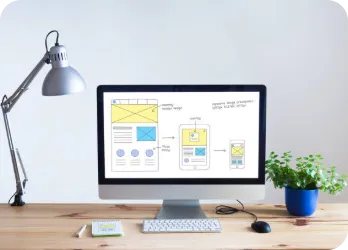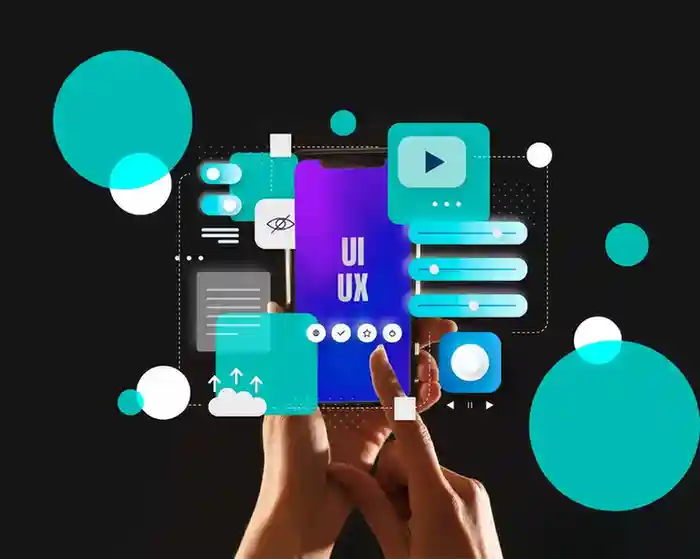
UI/UX DEVELOPMENT COMPANY
Embrace innovation with designs that effortlessly connect users to digital experiences, setting new standards for interaction.
CRAFTING EXPERIENCES, DEFINING INTERACTIONS
At Vegavid, we specialise in creating seamless, intuitive, and visually captivating user experiences through our cutting-edge UI/UX development services. Our passion lies in crafting digital interactions that transcend mere functionality, elevating user engagement and satisfaction to unprecedented levels.
Vegavid is a team of innovative designers, developers, and visionaries united by a common goal: redefining digital experiences. We thrive on the principles of creativity, functionality, and user-centric design, ensuring our solutions not only meet but exceed expectations.

OUR UI/UX DEVELOPMENT SERVICES
Tokenomics typically involves:
User-Centric Design

Wireframing & Prototyping
_1751009313260.webp)
Creating comprehensive wireframes and prototypes to visualise and refine the user journey and interface interactions.
Visual Design & Branding
_1751009416221.webp)
Responsive UI Development
_1751009454924.webp)
Building responsive interfaces optimised for diverse devices and screen sizes, ensuring a seamless user experience across platforms.
Usability Testing & Optimization
_1751009596975.webp)
Interactive Microinteractions

KEY SIGNIFICANCE OF UI/UX FOR BUSINESS SUCCESS
UI/UX (User Interface/User Experience) holds immense importance for businesses due to several key reasons:

Enhanced User Satisfaction
Intuitive and visually appealing interfaces elevate user satisfaction, fostering positive experiences that encourage user retention and loyalty.

Increased Engagement
Well-designed UI/UX captivates users, keeping them engaged longer and encouraging them to explore more, leading to higher interaction rates.

Improved Conversion Rates
Intuitive interfaces streamline user journeys, making it easier for users to navigate, resulting in increased conversions and achieving business goals.

Brand Reputation

Reduced Costs
Investing in UI/UX early on mitigates the need for extensive redesigns or fixes later, ultimately saving on costs and resources.

Competitive Edge
Stand out in a crowded market by offering superior user experiences, gaining a competitive advantage over rivals.

Customer-Centric Focus

Adaptability & Innovation
EXPERIENCE INNOVATION IN EVERY PIXEL – VIEW OUR PORTFOLIO
View our showcase of innovative UI/UX designs and experiences.
WHY CHOOSE VEGAVID UI/UX DEVELOPMENT COMPANY?
_1751011401480.webp)
User-Centred Design
_1751011437612.webp)
Our team embraces the latest design trends and technologies, delivering cutting-edge UI/UX experiences.
Innovative Solutions
_1751011465306.webp)
We believe in transparent communication and collaboration, working closely with clients to achieve their vision.
Collaborative Partnership
_1751011494709.webp)
Our commitment to excellence ensures the highest standards of quality and performance in every project.
Quality Assurance
BOOST USER SATISFACTION – SCHEDULE A FREE UI/UX STRATEGY SESSION
Schedule a consultation with our experts to elevate your digital presence.
OUR APPROACH TO UI/UX DEVELOPMENT
At Vegavid, our UI/UX approach revolves around a user-centric process:

Understanding Users
We deeply analyse user behaviours and preferences to create designs that resonate.

Ideation & Prototyping
Brainstorming innovative ideas translated into tangible prototypes.

Collaborative Design

Iterative Testing
Rigorous testing and refinement guarantee intuitive user experiences.
READY TO ELEVATE YOUR PRODUCT? GET A UI/UX DEMO TODAY
Experience firsthand how our UI/UX solutions can benefit your business.
OUR TECH STACK
Our toolkit at Vegavid is a fusion of industry-leading technologies and platforms that empower us to deliver exceptional UI/UX solutions. We leverage a versatile array of tools tailored for designing, prototyping, and development. Our tech stack includes:
| Design Tools | |||||
| Prototyping: | |||||
| Development: | |||||
| Usability Testing: | |||||
| Version Control: |
INDUSTRY-SPECIFIC SOLUTIONS: TAILORING UI/UX FOR UNIQUE SECTOR CHALLENGES
At Vegavid, we understand that different industries have distinct user needs and challenges. Our UI/UX services are crafted to address these unique requirements, ensuring tailored solutions that cater to specific industry demands. We specialise in delivering exceptional user experiences across various sectors:
FAQs
UI/UX design plays a pivotal role in driving business growth by directly impacting user behaviour and conversions. Intuitive and user-friendly interfaces lead to higher user engagement and satisfaction, resulting in increased conversions, decreased bounce rates, and improved brand loyalty. Additionally, a positive user experience often leads to organic referrals and positive word-of-mouth, contributing to a broader customer base and sustained business growth.
The UI/UX design process typically includes several phases—research, ideation, design, prototyping, testing, and implementation. It starts with in-depth user research to understand user behaviours and preferences. Ideation involves brainstorming and conceptualization of design ideas. Design and prototyping translate ideas into visual mockups and interactive prototypes. Testing involves rigorous evaluation, gathering feedback, and refining the design. Implementation brings the finalised design to life.
Mobile app success heavily relies on UI/UX design as it directly influences user satisfaction and engagement. Mobile users seek seamless experiences with easy navigation, visually appealing interfaces, and intuitive interactions. A well-designed UI/UX ensures optimal performance across various devices, enhances usability, and addresses specific mobile user needs. It directly impacts user retention, app downloads, and overall app success.
User research is the cornerstone of effective UI/UX design. It involves gathering insights into user behaviours, needs, motivations, and pain points. This research guides the design process, ensuring that the final product caters to user expectations and preferences. It helps in creating personas, user journey maps, and empathy maps, enabling designers to make informed decisions and design solutions tailored to user requirements.
Responsive design is integral to UI/UX, ensuring seamless experiences across various devices and screen sizes. It allows interfaces to adapt and adjust to different resolutions, optimising content layout and functionality. Responsive design ensures consistency, usability, and accessibility, regardless of the device used. It enhances user satisfaction and reduces bounce rates by delivering a consistent and intuitive experience.
Current UI/UX design trends focus on immersive experiences, minimalistic designs, dark mode interfaces, voice user interfaces (VUI), augmented reality (AR) integration, micro-interactions, and personalised user experiences. These trends aim to create engaging, visually appealing, and user-centric designs that resonate with modern user expectations.
UI/UX design success can be measured through various metrics such as user engagement, conversion rates, bounce rates, time spent on the interface, user satisfaction scores, and task success rates. Analysing these metrics provides insights into the effectiveness of the design, identifies areas for improvement, and helps in refining the UI/UX to align better with user needs and business goals.
Get In Touch With Us
Fill out the form below and our team will get back to you soon

_1751013895031.webp)
_1751013894972.webp)
_1751013894923.webp)
_1751014177551.webp)
_1751014177503.webp)
_1751014177141.webp)
_1751014372408.webp)
_1751014372449.webp)
_1751014372360.webp)
_1751014372116.webp)
_1751014372129.webp)
_1751014503921.webp)
_1751014503851.webp)
_1751014503759.webp)
_1751014635076.webp)
_1751014635008.webp)
_1751014634726.webp)
_1751015874644.webp)
_1751015949946.webp)
_1751016061918.webp)
_1751016117298.webp)
_1751016214327.webp)
_1751020462488.webp)